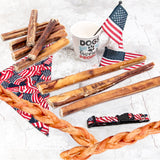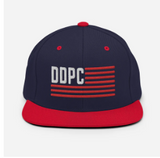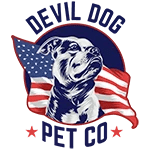Every morning when I head downstairs, our dog Dexter is already waiting by his feeding station—eyes locked on me, tail wagging with the subtle intensity of a helicopter preparing for takeoff. It's a daily reminder that for dogs, mealtime isn't just about nutrition—it's a highlight of their day. Yet most owners put more thought into what goes into the bowl than the bowl itself.
That's a mistake. The right dog bowl isn't just a container; it's a tool that can improve digestion, slow down speed-eaters, reduce joint strain, and even help prevent serious health issues. After years of testing dozens of options with Dexter and working with countless dog owners, I've learned that proper feeding equipment is as crucial as proper food.
Let's cut through the marketing hype and get to what actually matters when choosing dog bowls that serve both you and your four-legged drill instructor.
Dog Bowls: The Foundation of Feeding Success

Dog bowls come in various materials, shapes, and designs—each serving different purposes beyond simply holding kibble or water. The right bowl can make the difference between comfortable, healthy feeding and potential problems ranging from minor discomfort to serious digestive issues.
While a bowl might seem like a simple purchase, making the wrong choice can lead to problems that affect your dog's health and your home. I've seen everything from bloat in rapid eaters to neck strain in large breeds forced to bend too low—all preventable with the right equipment.
Why Your Dog Bowl Choice Matters
When a customer came to me describing how her Labrador would inhale food in seconds then vomit it back up, the solution wasn't medication or expensive specialty food—it was switching from a standard stainless steel dog bowl to a slow feeder. Problem solved for under $20.
Another customer's senior German Shepherd struggled with arthritis until we elevated his feeding station. The change in posture during meals reduced his discomfort significantly, showing how something as simple as bowl height can impact quality of life.
These aren't isolated cases. The right dog bowl addresses specific needs:
- Proper digestion and reduced bloat risk
- Joint and neck comfort during feeding
- Dental health maintenance
- Hydration encouragement
- Portion control and weight management
The 5 Essential Types of Dog Bowls Every Owner Should Know
After testing countless options with dogs of all sizes and temperaments, I've identified five fundamental bowl types that cover virtually every canine need. Understanding these options is step one in making an informed choice.
1. Standard Stainless Steel Dog Bowls: The Marine-Grade Option
If dog bowls were military gear, stainless steel dog bowls would be the standard-issue equipment—reliable, virtually indestructible, and gets the job done without complaints.
Stainless steel pet bowls earn their place as the gold standard for everyday feeding. They're non-porous, which means bacteria have nowhere to hide, unlike plastic bowls that develop microscopic scratches harboring germs. They're also dishwasher-safe, won't leach chemicals, and can handle the rough-and-tumble lifestyle most dogs dish out.
When selecting stainless steel dog food bowls, look for:
- Food-grade stainless steel (18/8 or 304-grade)
- Seamless construction (no welded parts that can trap food)
- Non-skid rubber base or a separate mat to prevent sliding
- Appropriate size (large stainless steel dog bowl for big breeds, small stainless steel dog bowls for puppies or toy breeds)
Not all metal dog bowls are created equal. Avoid cheap alternatives that may contain lead or other contaminants. USA-made stainless steel dog bowls typically meet higher manufacturing standards, though they command premium prices. The investment pays off in longevity—a quality bowl can last your dog's entire lifetime.
2. Slow Feeder Bowls: The Speed Trap Your Dog Needs
Some dogs approach mealtime like it's a competitive sport. Dexter used to inhale his food so fast I swear he didn't even taste it. This isn't just messy—it's dangerous. Rapid eating increases choking risk and can lead to bloat, a potentially fatal condition where the stomach twists.
Slow feeder bowls feature ridges, mazes, or obstacles that force dogs to work around barriers to access their food. The design transforms eating from a sprint into a puzzle, slowing consumption by up to 10 times.
Benefits extend beyond safety—these bowls provide mental stimulation, turning mealtime into enrichment. Dogs are natural foragers, and slow feeders tap into this instinct, making meals more satisfying and engaging.
The best slow feeders come in various difficulty levels. Start with simpler patterns for food-motivated dogs who might get frustrated, then graduate to more complex designs as they adapt. Many are available in stainless steel versions that combine durability with feeding control.
For more detailed guidance on selecting slow feeder bowls, check out this expert article on food bowl selection.
3. Elevated Dog Bowls: Standing Tall for Joint Health
Watching a large dog hunch over a floor-level bowl is like watching a Marine try to do pushups with improper form—it hurts to see and causes unnecessary strain. Dog high bowls (elevated feeders) raise food and water to a more natural eating position.
Elevated dog bowls can benefit:
- Large and giant breeds who otherwise must bend uncomfortably
- Senior dogs with arthritis or mobility issues
- Dogs recovering from neck or back injuries
- Breeds prone to digestive issues like megaesophagus
The ideal height allows your dog to eat with their neck in a neutral position—generally at or slightly below chest level. Some stands offer adjustable heights to grow with puppies or serve multiple dogs.
Many elevated feeders include stainless steel dog food bowls that can be removed for cleaning, combining the benefits of proper height with hygienic materials. Non-slip dog bowls or rubber gaskets prevent shifting during enthusiastic eating sessions.
For a comprehensive evaluation of the best dog bowls including elevated options, visit this detailed review.
4. Travel and Collapsible Dog Bowls: Field-Ready Feeding
Every dog owner needs a portable solution. Whether you're hiking trails, making a road trip, or deploying to the dog park, collapsible dog bowls provide practical feeding options away from home.
Modern travel bowls fold flat or collapse into compact shapes, taking up minimal space in backpacks or glove compartments. Silicone versions pop open when needed and clean easily with a quick rinse.
While these aren't your everyday feeding solution, they're essential gear for:
- Day trips and outdoor adventures
- Emergency preparedness kits
- Office dogs who come to work
- Travel and camping excursions
Look for BPA-free materials and carabiners or clips that attach to leashes or packs. Some designs include separate compartments for food and water, functioning as all-in-one meal kits for dogs on the move.
5. Specialized Feeding Solutions: Custom Approaches for Unique Needs
Beyond the standard options, specialized bowls address specific challenges:
Copper dog bowls offer antimicrobial properties and striking aesthetics, though they require hand washing and regular polishing to prevent tarnish.
Tilted dog bowls angle food toward brachycephalic (flat-faced) breeds like Bulldogs and Pugs, making it easier to access kibble without pushing the bowl around.
Heavy-duty stainless steel dog bowls with weighted or rubber bases stand up to the most determined bowl-flippers and food-pushers.
Name dog bowls with personalization add style while ensuring the right dog gets the right food in multi-pet households.
For dogs with specific medical conditions, consult your veterinarian about specialized feeding equipment that might help manage symptoms or improve quality of life.
Material Matters: Choosing the Right Dog Bowl Construction

The material of your dog bowl isn't just about aesthetics—it's about safety, durability, and function. Each option comes with distinct advantages and potential drawbacks.
Stainless Steel: The Gold Standard
When a customer asks me what bowl I recommend without hesitation, I point to quality stainless steel every time. These workhorse bowls offer unmatched benefits:
- Virtually indestructible (I've had the same stainless steel pet bowls for Dexter for years)
- Non-porous surface prevents bacteria buildup
- Won't absorb odors or stains
- Dishwasher-safe for easy sanitizing
- No chemicals leaching into food or water
The best stainless steel dog bowls feature a non-slip base or come with a silicone mat to prevent sliding across floors during enthusiastic eating sessions. For multi-dog households, large stainless dog bowls with straight sides minimize spillage and maximize capacity.
Ceramic: Style Meets Substance
Ceramic dog bowls offer aesthetic appeal with practical benefits. These heavier options stay put during feeding and often feature artistic designs that complement home décor. However, they come with important considerations:
- Check for lead-free, food-grade glazes
- Inspect regularly for chips or cracks that harbor bacteria
- Choose options with non-slip bottoms for stability
- Hand-wash or use gentle dishwasher cycles to preserve finish
Ceramic works well as a dog plate style for flat-faced breeds who struggle with deep bowls. The weight prevents pushing and tipping, while the flat surface allows easier access to food.
Plastic: Convenience with Cautions
While inexpensive and lightweight, plastic dog bowls come with significant drawbacks that make them my least recommended option:
- Develop microscopic scratches that harbor bacteria
- May contain BPA or other harmful chemicals
- Absorb odors and can develop "dog bowl smell"
- Easily chewed and damaged by determined dogs
If you must use plastic, choose BPA-free options, replace them at the first sign of scratching or damage, and sanitize regularly. Better yet, consider them only for temporary travel situations where weight matters more than longevity.
Material Selection Based on Dog Personality
Beyond general recommendations, match bowl material to your dog's specific traits:
For the destroyer: Heavy-duty stainless steel dog bowls resist even the most determined chewers and can't be flipped or carried away.
For the sensitive: Some dogs develop "whisker fatigue" from deep, narrow bowls. Wide, shallow stainless steel pet bowls or a dog plate style provides comfortable access.
For the messy eater: Large metal dog bowls with high sides contain splashes and kibble flinging. Pair with a silicone mat for complete cleanup simplicity.
Remember that no single bowl works for every situation. Many owners maintain a collection—stainless for daily feeding, slow feeders for gulpers, and collapsible options for travel. The right tool for the right job applies to dog gear as much as it does to military equipment.
Finding Your Dog's Perfect Bowl Match

Choosing the right dog bowl isn't about marketing hype or the latest trends—it's about addressing your dog's specific needs while making your life easier. After helping countless owners through this decision, I've developed a simple three-step approach:
Finding Your Dog's Perfect Bowl Match
When selecting dog bowls, consider three crucial factors: your dog's eating style, health needs, and your lifestyle requirements. This practical approach cuts through marketing noise and focuses on what actually matters.
1. Assess Your Dog's Eating Style
Speed eaters need slow feeders or puzzle bowls to prevent dangerous gulping. Side-to-side pushers benefit from non-slip dog bowls with rubber bases or heavy stainless steel pet bowls that stay put. Messy eaters require high-sided bowls that contain splatter, while picky eaters often prefer wide, shallow dishes that don't touch their whiskers during meals.
A customer's Labrador transformed from a 30-second inhaler to a 5-minute thoughtful eater simply by switching to a spiral-patterned slow feeder. The right bowl can fundamentally change mealtime behavior.
2. Address Health Considerations
Flat-faced breeds need tilted or shallow dog bowls that accommodate their unique anatomy. Senior dogs with arthritis benefit from elevated feeders that reduce neck strain. Dogs with dental issues may need softer food served in stainless steel dog food bowls that won't harbor bacteria from wet food residue.
For dogs with food allergies, metal dog bowls provide the safest, most non-reactive surface. Large stainless steel dog bowls work particularly well for dogs with skin sensitivities since they won't cause contact reactions like some plastic varieties.
3. Match to Your Lifestyle
Dishwasher owners can freely choose dishwasher-safe options like stainless steel pet bowls. Frequent travelers need collapsible or lightweight options. Apartment dwellers might prioritize quiet, non-skid designs that won't wake neighbors when kicked across hardwood floors at 5 AM.
If aesthetics matter in your home, numerous stylish options exist—from copper dog bowls that develop character with age to personalized name dog bowls that complement your décor while serving a practical purpose.
Maintenance: Keeping Dog Bowls Safe and Sanitary
Dog bowls rank among the top five germiest items in most homes—often harboring more bacteria than toilet seats. Proper maintenance isn't just about cleanliness; it's about preventing disease.
Daily Cleaning Protocol
Wash dog bowls daily with hot, soapy water or run them through the dishwasher. This applies to all materials, but especially to plastic dog bowls which develop micro-scratches that trap bacteria. Small stainless steel dog bowls can be sanitized by filling with boiling water and letting stand for five minutes before washing—particularly useful after illness.
For busy households, keep multiple sets of bowls in rotation. This Marine-approved system ensures clean bowls are always available even when life gets hectic. USA-made stainless steel dog bowls typically withstand thousands of wash cycles without degradation.
Replacing Worn Bowls
Inspect bowls regularly for damage that could harbor bacteria or create sharp edges. Replace plastic bowls at the first sign of scratches or bite marks. Ceramic bowls should be discarded if cracked, as bacteria can penetrate the porous material beneath the glaze.
Quality stainless steel dog food bowls rarely need replacement unless they develop rust spots (which indicates they're not true stainless steel) or the non-slip base deteriorates. A good large stainless dog bowl often outlasts several plastic replacements, making it more economical despite the higher initial investment.
Specialized Cleaning for Travel Bowls
Collapsible silicone bowls require special attention to prevent mold growth in folded sections. After washing, expand fully and air dry completely before storing. For extended trips, pack cleaning wipes specifically formulated for pet dishes to maintain hygiene on the go.
Learn more about safe and effective bowl options for your companion at Hemopet's guide to food and water bowls.
The Bottom Line: Leadership Starts at Mealtime
At Devil Dog Pet Co., we believe proper feeding equipment is a fundamental expression of responsible dog ownership. The right dog bowl isn't just about convenience—it's about health, safety, and respect for your dog's specific needs.
Whether you choose heavy duty stainless steel dog bowls for durability, non-slip dog bowls for enthusiastic eaters, or specialized options for unique requirements, your selection demonstrates leadership. By providing appropriate tools for this essential daily activity, you're setting clear expectations and boundaries—cornerstones of Extreme Dog Leadership.
Remember that dogs thrive on consistency and structure. A dedicated feeding station with appropriate bowls establishes routine and reinforces your role as provider. This seemingly small detail lays groundwork for broader training success and household harmony.
The best bowl is one that serves both your dog's needs and your practical requirements. Stainless steel remains our top recommendation for most situations, but the perfect match ultimately depends on your specific circumstances. Assess honestly, choose wisely, and maintain diligently—your dog deserves nothing less.
Final Thoughts: Beyond the Bowl
Choosing the right dog bowl is important, but what you put in it—and how you use it—matters even more. Quality nutrition, proper portions, and a consistent schedule are key. Even the best large metal dog bowl means little if it's filled with poor food or used inconsistently.
When Dexter moved to adult food, we upgraded everything: his diet, bowls, schedule, and mealtime training. This complete approach turned feeding into more than a routine—it became a foundation for discipline and connection. That’s what Extreme Dog Leadership is all about: seeing how small choices create big results for a balanced, well-behaved dog. Curious about your dog’s quirky eating habits? Why Does My Dog Do That? breaks it down—and shows how the right bowl can make a difference.
Download the FREE 10-Step Dog Prep Guide
Frequently Asked Questions
What type of bowl is best for dogs?
The best type of dog bowl depends on your dog's needs and your preferences, but generally, stainless steel bowls are highly recommended due to their durability, ease of cleaning, and resistance to bacteria. Ceramic bowls are also popular for their aesthetic appeal and weight, which helps prevent tipping, but they can chip and harbor bacteria if damaged. Plastic bowls are less ideal because they can scratch easily and harbor germs, potentially causing skin irritation for some dogs.
Should your dog bowl be elevated?
Elevating your dog's bowl can be beneficial, especially for larger breeds or dogs with arthritis or other mobility issues, as it reduces strain on their neck and joints. However, for most dogs, especially smaller breeds, a bowl placed on the ground works perfectly fine. It's important to observe your dog's comfort and consult your vet if you have concerns about their eating posture.
Do dogs prefer ceramic or stainless steel bowls?
Dogs themselves don't have a strong preference between ceramic and stainless steel bowls, but the choice can affect their eating experience. Stainless steel bowls are less likely to retain odors and are more hygienic, while ceramic bowls can be heavier and more stable, preventing spills. Ultimately, your dog's behavior and comfort can guide the best choice.
Are Yeti dog bowls worth it?
Yeti dog bowls are often considered worth the investment due to their high-quality materials, durability, and insulation features that help keep water cool for longer periods. They are designed to withstand rough use and outdoor conditions, making them ideal for active dogs and owners who love outdoor adventures. However, if you're looking for a basic bowl for everyday use, there are more affordable options that also get the job done.
Do vets recommend stainless steel bowls?
Yes, many veterinarians recommend stainless steel bowls because they are non-porous, easy to clean, and do not harbor bacteria as easily as plastic or damaged ceramic bowls. Stainless steel is also less likely to cause allergic reactions or skin irritations in dogs. For these reasons, it's often the preferred choice in veterinary clinics and pet care settings.
How high should a dog's bowl be off the ground?
The ideal height for a dog's bowl depends on the size of the dog; generally, the bowl should be elevated so that your dog's head is level with their shoulders when eating. This helps promote better posture and easier swallowing, especially for larger breeds. For small dogs, placing the bowl just slightly off the ground or on the floor is usually sufficient.






